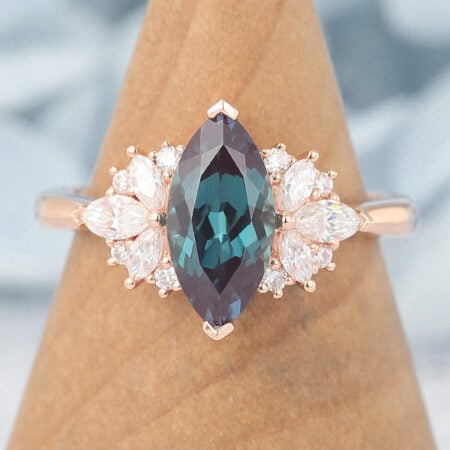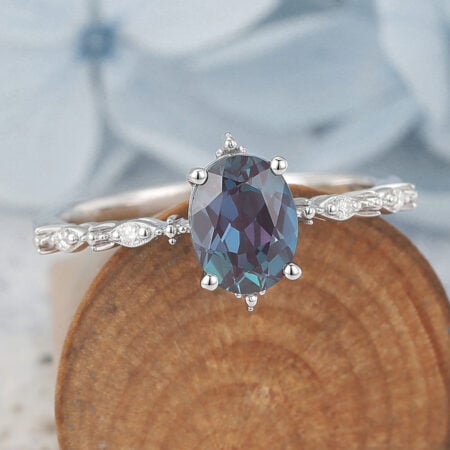Alexandrite Meaning: The Color-Changing Gem
Alexandrite is a rare and highly sought-after gemstone known for its captivating color change. Its popularity continues to grow, inspiring many to explore the deeper Alexandrite Meaning behind this remarkable stone. We’ll explore the meaning of the alexandrite stone here for your better shopping.
What Is Alexandrite?
The clear definition for alexandrite stone is that it is a semi-precious gemstone known for its unique color-changing effect. Belonging to the chrysoberyl family of beryllium aluminum minerals, it shows green to bluish-green hues under natural daylight and shifts to red or purplish-red under incandescent or indoor lighting. This remarkable trait makes alexandrite highly prized and collectible in the jewelry world.

The History of Alexandrite Stone
The origin of alexandrite is interesting. Alexandrite was first discovered in the Ural Mountains of Russia in the 1830s and was named after Emperor Alexander II. Its color changes symbolize the green uniforms and red flags of the Russian Empire, and it is loved by the royal family and nobility for its unique charm.
However, natural alexandrite resources in the Ural mining area became scarce. Later, new deposits were discovered in Sri Lanka, Brazil, and Tanzania, and modern laboratory cultivation technology also made alexandrite more accessible, promoting its popularity in the market.
Alexandrite Meaning and Symbolism
The meaning of the alexandrite gemstone is rooted in its extraordinary ability to shift colors, which has long been associated with transformation, duality, and emotional balance. Across various cultures, this rare stone is seen as a symbol of change, reflecting the constant movement between light and shadow, certainty and mystery. Because of its dual nature, alexandrite symbolism often relates to personal evolution, helping the wearer navigate life’s transitions with clarity and resilience.
It is also thought to support self-reflection and inner strength, making it a meaningful choice for individuals seeking renewal or facing major turning points in life. The gem’s historical ties to Russian royalty further enhance its image as a stone of power, destiny, and uncommon beauty.
Meaning of Alexandrite Gemstone As the June and Zodiac Birthstones
Alexandrite is the birthstone for June and is known for its ability to change color with light – green in natural light, turning reddish purple under light. This characteristic is often seen as a symbol of balance, adaptability and change, making it a gemstone of jewelry choice for many people during times of transition.
In the zodiac, Alexandrite is more associated with Gemini and Cancer. It is believed to help Gemini clarify their thoughts and enhance their judgment, and it can also stabilize Cancer’s emotional state. In terms of meaning, Alexandrite represents inner growth and self-adjustment, and is suitable for those who want to maintain emotional balance and strengthen their inner connection.
Physical and Energetic Properties
Spiritual Properties of Alexandrite
Alexandrite is often considered to have the function of balancing energy, especially for people who are prone to emotional fluctuations or are going through a transition. It can help the wearer to sort out their thoughts, enhance intuition and inner awareness, and thus achieve a more stable state on the spiritual level. The spiritual meaning of Alexandrite is usually understood as “maintaining inner clarity in change”, which symbolizes the self-control and emotional reconciliation ability of people in the face of uncertainty.
Metaphysical Properties of Alexandrite
The metaphysical properties of alexandrite are believed to be related to the “heart chakra” and the “third eye chakra”, symbolizing an open mind, sharp intuition, and enhanced cognitive abilities. It is often used in meditation practice, emotional regulation, or magnetic field balance, and is also regarded as one of the protective crystals. Due to its unique color-changing properties, alexandrite is not only seen as a conductor of energy, but also as a spiritual carrier that can help maintain harmony between the inner and outer states.
Healing Properties of Alexandrite
The healing properties of alexandrite can help relieve emotional tension, soothe internal stress, and enhance an individual’s ability to adapt to changes in the environment or life. Some users believe that it can help restore emotional energy and improve psychological resilience, especially suitable for wearing when feeling depressed or mentally exhausted. Due to the sense of stability brought by its color changes, alexandrite is also regarded as one of the auxiliary stones that support inner repair and energy reorganization.

Alexandrite vs Other Color-Changing Gems
Alexandrite vs Color-Change Garnet
Color-change garnet can shift from greenish tones to reddish-purple, but its change is usually less distinct than alexandrite’s dramatic green-to-red transition. Garnets are more common and affordable, making them accessible, though they lack the rarity and prestige of alexandrite.
Alexandrite vs Color-Change Sapphire
Color-change sapphires typically shift from blue in daylight to purplish hues under indoor lighting. While durable and beautiful, their optical shift is subtler and less consistent compared to alexandrite. Alexandrite remains more desirable due to its vivid, well-defined change.
Alexandrite vs Fluorite
Some fluorites display color change, but their softness (Mohs 4) limits their use in jewelry. Alexandrite, with a hardness of 8.5, is much more suitable for rings and daily wear. Fluorite also lacks the rarity and market value alexandrite holds.
Alexandrite vs Diaspore (Zultanite)
Diaspore, also known as Zultanite, shows a gentle color shift from greenish-yellow to pinkish-champagne tones. While attractive, its color change is more subtle and lacks the dramatic duality that makes alexandrite unique. Alexandrite also remains far rarer and more collectible.
Celebrities and Royalty Who Chose Alexandrite Gemstones
Princess Grace of Monaco–Owned an alexandrite and diamond brooch, gifted during a royal visit.
Queen Elizabeth II–Reportedly received an alexandrite ring as part of her gemstone collection.
Penélope Cruz–Wore vintage alexandrite earrings on the red carpet at a film premiere.
Katy Perry–Has been seen wearing a custom alexandrite cocktail ring during interviews.
Blake Lively–Spotted wearing a delicate alexandrite pendant layered with gold chains.
The Rise of Lab-Grown Alexandrite: Beauty with a Conscience
Lab created alexandrite offers the same stunning color shift and durability, with the hardness of alexandrite at 8.5. Valued for ethical sourcing and affordability, it delivers key alexandrite gemstone benefits. While the price of alexandrite stone can exceed that of diamonds, alexandrite price vs diamond comparisons show lab versions are more accessible—making them increasingly popular in modern jewelry.
Buying Guide: What to Look for in Alexandrite Jewelry
Color Change: Look for strong color shift—green in daylight and red in incandescent light is a mark of high-quality alexandrite.
Clarity: While inclusions are common, clearer stones with fewer visible flaws are more valuable and visually appealing.
Cut: A well-proportioned cut enhances both sparkle and color change, making the stone appear more vivid and dynamic.
Carat Weight: Larger alexandrite stones are rare and costly; smaller sizes offer beauty and affordability for everyday wear.
Origin: Russian origin is the most prized, followed by stones from Sri Lanka and Brazil, each with unique color profiles.
Lab vs. Natural: Lab-created alexandrite mimics the natural beauty at a lower price, while natural stones offer rarity and prestige.
Setting Style: Choose a setting that lets light enter the stone easily—open prong settings highlight its color-changing effect.
Conclusion
The Alexandrite meaning reflects adaptability and inner strength. Its captivating color change continues to fascinate collectors and those seeking a gem rich in symbolism. Browse Amanda’s Alexandrite ring jewelry to find your meaningful pieces.
FAQs About Alexandrite Meaning
What is an alexandrite stone? What does an alexandrite look like?
An alexandrite stone is a rare type of chrysoberyl known for its dramatic color-change effect, shifting between green and red under different light sources. Alexandrite looks green or bluish-green in daylight and changes to red or purplish-red under incandescent light, giving it a striking and mysterious appearance.
What stone is june? Is alexandrite a birthstone?
June has three birthstones: pearl, moonstone, and alexandrite. Yes, alexandrite is officially recognized as a June birthstone.
What color is an alexandrite stone? Does alexandrite change colors?
Alexandrite stone colors include green to blue-green in natural light and red to purplish-red under warm lighting. Yes, alexandrite famously changes colors depending on the light source.
What does alexandrite symbolize?
Alexandrite symbolizes balance, transformation, and intuition. It’s often associated with personal growth and adapting to change.
What is alexandrite used for?
Alexandrite stone jewelry is the most common use, especially in alexandrite gemstone rings, necklaces, and earrings due to its beauty and rarity.
How much are alexandrites worth?
The price of true alexandrite stone varies greatly depending on size, clarity, origin, and color change intensity. Natural alexandrites with strong color shift and high clarity can range from $5,000 to over $70,000 per carat. Lab-created stones are much more affordable, often priced between $200 to $1,500 per carat depending on quality.
What is the best cut for alexandrite gemstones?
The best cut for alexandrite gemstones is usually oval or cushion, which maximizes color change and brilliance while preserving weight and clarity.



